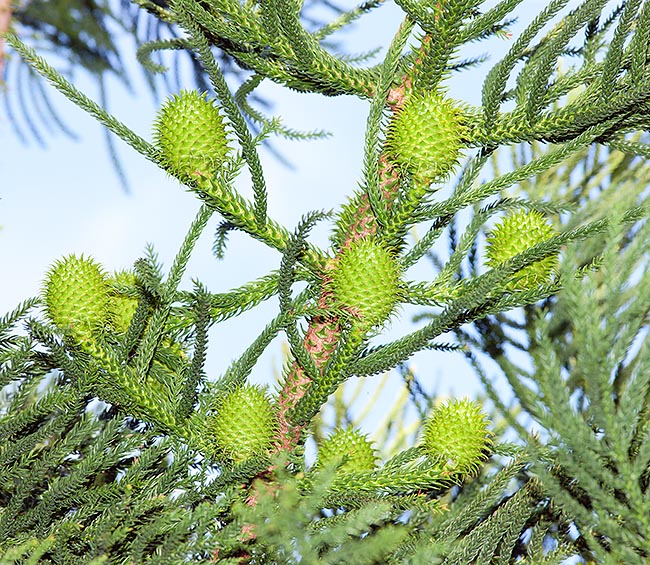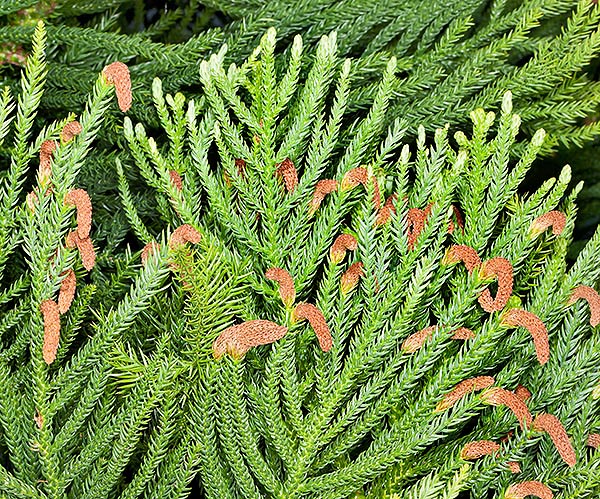Family : Araucariaceae

Text © Pietro Puccio

English translation by Mario Beltramini

Araucaria cunninghamii with 6-10 cm ovoid female cones in the upper part of the top © Giuseppe Mazza
The species is native to Australia (New South Wales and Queensland) and to New Guinea, where it grows in the tropical and subtropical forests up to 2700 m of altitude, in climates characterized by high rainfall.
The name of the genus comes from the name of a Chilean ethnic group, the Araucanos, in whose territories lives the first discovered species, the Araucaria araucana; the species is honoured to the English botanist and explorer Allan Cunningham (1791-1839).
Common names: colonial pine, Dorrigo pine, hoop pine, Moreton Bay pine, Queensland pine, Richmond River pine, rocket pine (English); nang yan shang (Chinese); pien, ningwik, alloa (Indonesian); araucaria d’Australie, araucaria de Cunningham, pin de hoop (French); pino australiano (Italian); araucária-de-Nova-Guiné, pinheiro-colonial, pinheiro-cunnigami, pinheiro-de arco, yau (Portuguese); araucaria de Australia, araucaria de Cunningham, pino de Australia, pino hoop (Spanish); son naam (Thai); Australischer Kiefer, Cunninghams Araukarie, Cunninghams Schmucktanne, Kolonialkiefer (German).
The Araucaria cunninghamii Aiton ex D. Don (1837) is an evergreen tree, tall up to 50-70 m with cylindrical trunk, erect, up to more than 1,5 m of diameter, with brown grey or blackish brown bark, wrinkled, fissured, that peels off in horizontal stripes, with even 6 to 8 main lateral branches arranged in whorls (inserted circularly on the same node) spaced of 1-4 m, placed more or less horizontally, at their turn thickly ramified at the extremity.
It has leaves with marked dimorphism, the leaves of the young plants up to about 10 years of age, are sessile, spirally placed almost at a right angle in respect to the axis of the branch, needle-like, rigid, falcate, with almost quadrangular section, 0,7-1,7 cm long and 0,2-0,3 cm broad at the base, of glossy green colour. The leaves of the adult plants and of the branches carrying the reproductive organs (cones) are placed in whorls, densely packed and imbricate, from ovate to triangular, with pointed or rounded apex, 0,6-1 cm long and 0,4 cm broad at the base, of dull green colour.

The 4-7 cm long male cones grow only on the low branches of the plant © Giuseppe Mazza
Unisexual inflorescences on the same plant, the male cones, produced in the lower half of the top, are terminal, solitary, cylindrical, slightly narrowed at the base and at the apex, 4-7 cm long and 1-1,3 cm of diameter, formed by scales tightly in contact, with 5-8 pollen cells on the lower surface, yellow at the anthesis, then brown red, the female ones, produced in the upper part of the top, are terminal, ovoid or ellipsoid, 6-10 cm long and 5-8 cm of diameter, of green colour, brown when ripe, with imbricate bracts 2-3 cm long, spirally placed, of form almost obovate with thin lateral wing and pointed and curved apex, each one being merged to an ovuliferous scale internally; the female cones take 18-22 months for ripening and then disintegrating.
The seeds, edible, are triangular, 1-1,5 cm long, with lateral membranous wing which fosters their dispersion through the wind; only a small proportion of the seeds is vital and they can be identified if they sink upon the buoyancy test. It reproduces by seed, in sandy soil kept humid in shaded position, with the first considerable production of fertile seeds between 20 and 25 years of age, or by propagation in vitro of segments of branches.
Imposing tree suitable to tropical and humid subtropical climates, it can stand sporadic drops of temperature just under the 0 °C, it grows in various types of soils, provided deep, fertile and well drained, but with good capacity of water retention, possibly acidic or neutral. The wood obtained is of excellent quality, light, and easy to work and to refine, of pale yellowish brown colour, utilized in countless applications, in particular for the production of plywood and in the joinery in general; plantations, besides the origin zones, do exist in south-eastern Asia, in Africa and America. Besides for the production of wood, it is used as ornamental in great parks and gardens.
Synonyms: Eutassa cunninghamii (Aiton ex D.Don) G.Don (1839); Eutacta cunninghamii (Aiton ex D.Don) Link (1841); Eutassa cunninghamii (Aiton ex D. Don) Spach (1841).
→ To appreciate the biodiversity within the ARAUCARIACEAE family please click here.
